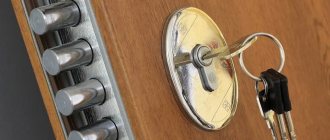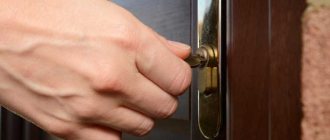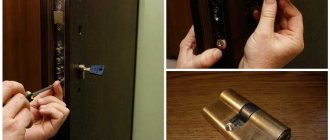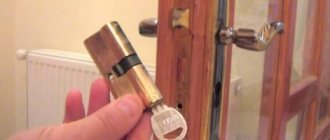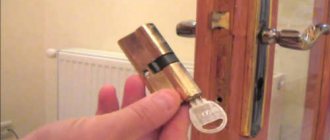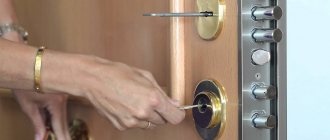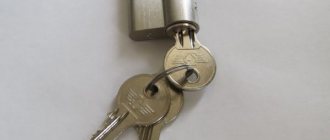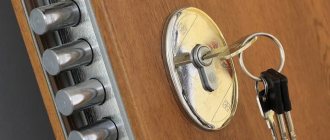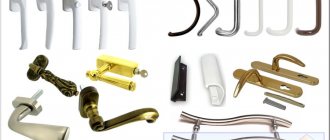A cylinder lock is a lock whose working part is a cylinder mechanism (the so-called “cylinder”).
The cylinder mechanism is the coded part of the cylinder lock, which ensures secrecy and moves the bolts, which can only be turned in the case when a standard (own) key is inserted into the hole inside the cylinder.
Initially, each manufacturing company patented and manufactured such a mechanism (core, or “larva”) of its own standard size, but from the second half of the twentieth century they began to produce a teardrop-shaped body with end fastening, thanks to which such blocks (larvae) from different manufacturers are now interchangeable.
Design and operating principle of a cylinder lock
Locks of this type owe their name to the main working part of the mechanism - the cylinder (popularly it is often called the secret or cylinder). The cylinder is a replaceable coded or secret lock mechanism; it is considered universal because it has standard dimensions. In addition to the cylinder, there is a locking mechanism or deadbolt drive. The “original” key activates a cylinder that controls the deadbolt drive, causing it to open or close the lock.
The design of a cylinder lock, in addition to the deadbolt drive itself and the cylinder, consists of a body (as a rule, it is made of metal or steel), spring-loaded pins, return springs, and a cam that moves the bolt. Pins can be of two types: those in contact with the key and those that block the lock mechanism relative to the body. Keys to cylinder-type locks are flat, with dimples (dents), teeth, or cutouts on the sides, the number of which is equal to the number of pins inside the cylinder. To increase the reliability of the lock, multi-row keys with perforation at the end are used.
Cylinder lock mechanisms are similar in operating principle, but differ in their design features, number of functions and degree of reliability. Accordingly, the cost of the lock varies: there is a noticeable difference in price between a locking mechanism that operates on the latch principle and a complex system equipped with vertical rods. The higher the security of a lock against burglary, the higher its cost. The most modern cylinder locks are protected from knocking out the secret, have a smooth drive and more than five code pins.
Operating principle and diagram
The most common type is the pin cylinder lock. It has a series of spring-loaded pins running through the cylinder and body. Each pin is divided into two parts of different lengths. When the key is not inserted into the lock, or someone else's key is inserted, the pins prevent the cylinder from turning. When “your” key is inserted into the lock, the ends of the pin halves are located exactly on the border between the cylinder and the body, as a result the cylinder turns easily.
In addition to pin locks, frame mechanisms of cylinder locks have become widespread. They use a series of spring-loaded frames with teeth as a secret. If the key is not inserted, or someone else's key is inserted, these teeth fit into the groove, preventing the cylinder from turning. Only when the correct key is inserted do the teeth come out of the groove, allowing the cylinder to turn. Frame locks are more compact than pin locks, but are more vulnerable to burglary.
How to replace a lock cylinder with your own hands
- Even before disassembling the cylinder of the old lock, it is advisable to lubricate the mechanism of the new cylinder. For these purposes, a special silicone grease is produced, but if you don’t mind spending money on it, buy regular machine oil;
Before removing the door lock cylinder, it is advisable to lubricate the mechanism; liquid types of machine oil are used for this.
- When disassembling, enter the lock hole with the key, open it and leave the key in the neutral position;
- Now let's disassemble the mount. To do this we need to unscrew the fixing screw. The head of the screw is located on the end plate of the lock, just opposite the cylinder. The screw is completely unscrewed and pulled out;
- When the screw is removed, the cylinder should come out freely;
If, after removing the fixing screw, the cylinder does not come out of the lock, try moving the key while simultaneously trying to pull out the cylinder. The locking cam must be in the zero position and then the mechanism will come out.
Replacing the lock cylinder of the front door with your own hands is not particularly difficult even for a complete amateur
- After removing the old larva, install a new one. If a new cylinder has not yet been purchased, then take the old one, go to the store and ask the seller for the same one, after which you insert it into the lock and tighten the fixing screw;
- Replacing the front door lock cylinder with your own hands is finished, you can use it.
Types of cylinder mechanisms
There are 5 types of cylinder mechanisms:
- Single row pin locks. They can be locking (cylindrical or “mushroom” shaped with a notch) or coded (cylindrical only). Single-row locks are made from brass or steel.
- Double-sided pin locks. To close/open these cylinder locks, arranged in two rows, a double-sided key is used.
- Locks with turning pins. The least common type of cylinder locks, characterized by the presence of rotary type code pins.
- Cross locks. The key and the shape of the keyhole of such a mechanism visually resemble a cross, because this is how the code pins are located inside the lock. Cross-shaped cylinder locks consist of three or four rows, which contain two or more pins.
- Locks with conical milling on the key. This is perhaps the most reliable type of cylinder locks, because the rows of pins are located in different planes, which greatly increases the number of options for code combinations for opening the lock.
What are the differences between DIN cylinders (cores)
Key type
The keys themselves may differ in their complexity and secrecy. It happens - English, perforated, semicircular (ABLOY type), interactive, chipped, with a magnetic tag, etc.
- English key
: is rightfully considered the most common type.
Such a key may differ in its profile, number and shape of “grooves” and “grooves” that are responsible for working with pins. The English key larva is considered the most susceptible to manipulation with o 3 .
Some manufacturers, to simplify the use of the key, began to produce a double-sided key. This key has mirror bits on both sides of the tip and can be inserted into the cylinder on either side.
- Semicircular key -
This option is not particularly resistant; simple locks are very susceptible to opening by manipulation. The latest developments of disk locks produced by Abloy are definitely an improved version of a conventional disk device, and are capable, as the manufacturer itself states, of resisting many modern hacking systems.
- Profile, perforated or perforated key This option is definitely more complicated than the English one; on the tip of such a key there is perforation in the form of round recesses where the pins should rest. Some key models may have perforation not only on the tip plane, but also on the end part, which is definitely a plus and increases the level of burglary resistance. The presence of a wavy groove in the form of a snake on the tip of the key indicates its greater secrecy; in the core with such a key there is a special frame that moves along the groove, which provides additional protection against “bumping”
Cam or gear
The cylinder may differ in the type of transmission of torque to the lock mechanism.
The most common type is cam, or flag.
But there is another option - a gear one; it can be immediately identified by the presence of a gear instead of a cam.
This type of mask is used by MUL-T-LOCK.
Key-key or spinner-key
If everything is clear on the outside and you need a key hole, then on the inside you need to decide how to lock it (with a key or a pin). It’s worth deciding which option is right for you: a wrench or a wrench.
Many people know that if a cylinder has key locks on both sides, and if you close it from the inside with the key left in it, you can no longer open the lock from the outside.
This fact serves as an argument for many when choosing just such a cylinder, since you can use the lock as an internal latch and not be afraid of anything. But not everyone knows that the lock can still be opened using the original key, but shortened by only a couple of millimeters.
This option has pros and cons, for example, an elderly person or child locking themselves from inside with a key, thereby blocking the ability to enter the room. On the plus side, this option may turn out to be a surprise for “window makers” who, having entered the room through the window, plan to exit through the door.
But more often, the key cylinder is used in walk-through doors, where only the owner of the key will be able to enter and exit.
Cylinder length
When installing, it is necessary to take into account the length of the protruding parts of the cylinder from the lock outward and inward.
That is, when choosing a cylinder, you need to know how much it should protrude from the outside of the lock in order for the armor plate to fit, and also how much it should protrude into the interior of the room so that it can be closed with a key or a turntable.
These indicators depend on the thickness of the door and the type of armor lining installed.
Burglary resistance
When choosing a cylinder, it is necessary to take into account such a factor as its burglary resistance.
Methods of influence can be different - manipulation with master keys, bumping, as well as force, such as drilling out a secret part with pins, breaking it in half or pulling the core out. Progress in design solutions does not stand still, so when choosing, it makes sense to pay attention to counteracting the above hacking methods .
- Protection against drilling -
Many manufacturers are now required to install a protective insert in the core and a hardened steel rod protecting the pins to combat drilling. - Protection against fracture and rupture -
To protect against rupture and fracture, a steel rod or spring is installed in the body to resist these actions. Some manufacturers, for example Mottura, make special grooves in the cylinder. When pulled out, the latter breaks along these grooves and at the same time the rotary cam remains inaccessible for turning. - Protection against manipulation -
But some manufacturers went even further and began to introduce interactive pins into the cylinders and supply the keys with magnets. When such a key gets into the cylinder, all standard pins work in standard mode, extending according to the grooves of the key, and the magnetic pin acts contrary to the influence of the magnet. Such a key is more likely to protect against normal manipulations, but may not protect against bumping.
Hacking protection
The reliability of resistance to burglary depends on the class (I-IV) and is characterized by the time (min) required to destroy the main elements of the lock:
- Drilling out the lock/security mechanism for class I-IV: 2; 5; 15; 30 minutes.
- Unscrewing the contents of the cylinder, for class II-IV: 50, 100, 250 Nm.
- Mechanical loads in the form of impact, for class II-IV: 80, 150, 300 J.
The cylinder mechanism has a secret of varying complexity, depending on the number of combinations created by the pins. The length of the locking pin is the same, unlike coded ones. The number of combinations (N) and complexity are determined by the number of notches n and notches k on the working surface of the key, total: N = nk
Repair
There are several reasons why a lock needs to be repaired. This can happen due to wear and tear on the internal elements, after a break-in attempt, or after unsuccessful attempts to open the door with someone else's key. It is possible that the lock cylinder can be repaired for other reasons; no one can rule out a manufacturing defect either.
In addition, you may experience sagging of the door leaf, which will sooner or later lead to a breakdown of the mechanism. But the most common reason for which a cylinder needs to be replaced is the loss of keys.
Repair
Usually you can change the cylinder yourself or invite professionals to do this, because the work is not the easiest. But first you need to assess the situation soberly: is there any reason to repair it? Perhaps it would be more advisable to replace the lock? By answering these questions, you will make the right decision and determine the stages of further action.
Voted over 274 times, average rating 4.2
Comments
Unfortunately, there are no comments or reviews yet, but you can leave your...
Add a comment Cancel reply
We recommend reading
Locks, Fittings Magnetic locks and other fittings for silent interior doors In apartments where large families live with an intensive lifestyle, comfort ...
Locks, Accessories What do you need to know when choosing a lock for a sliding door and when installing it? When planning to install sliding doors, most people think about the size and...
Locks, Accessories Features of choosing a high-quality lock for a fire door Fire doors reliably protect premises. If it happens...
Locks, Accessories Recommendations for installing a lock into a wooden door yourself The front door is a reliable barrier to intruders entering the house. ...
